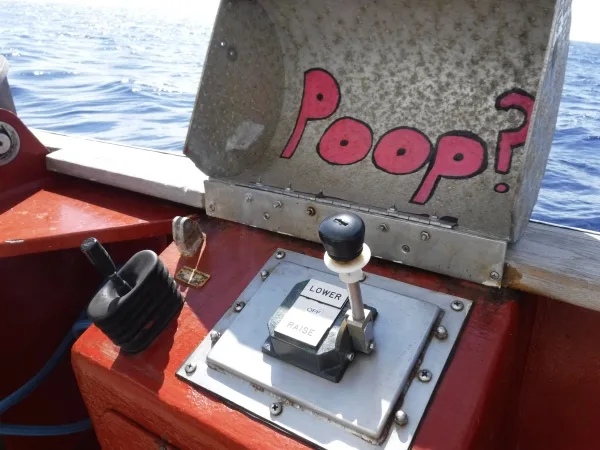Programs Blog
The Ecosystem of a Ship

Ava-Rose Beech, Kenyon College
Ship’s Log
Location
38 degrees 56’ S, 179 degrees 45’ E
On our first full, 6-hour watch underway on the ship, I was assigned to the engine room. During our time here, each student gets the opportunity to spend a day in the life of the ship’s engineers (the dynamic duo: Henry and Sonia). I was excited to venture down into the tiny engine room, filled with the humming and heat of the various machines that make running our daily lives and operations on the ship possible.
As it happened, Henry and Sonia had finished most of their work for the day, so they asked me if there was anything in particular I wanted to learn about. I thought about it for a minute, before asking them to explain how the boat’s sewage system works. Sonia proceeded to draw out a diagram of the life trajectory of everything that goes into the toilet. Powered by a vacuum, all of our waste gets broken up and sent to a storage container, before getting pumped off the side of the boat when we are underway, or treated for sanitation and then sent out of the boat when we are in port. Sonia and Henry explained this process to me in much more detail, using much more engineer-type vocabulary. Sonia then gave me an up close, in person tour of the boat’s sewage system, including a good couple minutes spent watching “poop T.V,” the popular television channel that displays waste product being sent and mixed up through a small window into the systems tank in the engine room every time someone flushes≈this channel is evidently a consistent fan favorite with students.
I think this topic speaks to one of the most valuable lessons being a member of this boat’s community can teach students≈ understanding ourselves as a part of the ecosystems we exist in. Living on a boat, for me, has magnified the many processes we are reliant on in our everyday lives. Here, however, all of these daily functions take place within the same 134-foot space we all eat, sleep, cook, and work in.
As we study ocean ecosystems, and the rich marine life surrounding us, from phytoplankton and zooplankton to flying fish, mola molas, and soaring albatrosses, I think the boat too functions as an ecosystem. The sewage system is just one example of this. To me, the beauty in studying a healthy, thriving ecosystem is the diversity of activity simultaneously occurring. At any given hour aboard the ship, there is a continual hum of activity; sounds that speak to the wide array of people and parts working to support our community as a whole. Early in the wee hours of the day, at 3 or 4 in the morning, there could be students processing chlorophyl-a and pH samples, while others venture out onto the bowsprit and set the jib in complete darkness, millions of stars shining above us. At the same time, others are sleeping soundly down below, or maybe snacking on a very early morning chocolate chip cookie. Amidst all this action, the water makers continue to work, providing us with fresh water to drink, the refrigeration system enables us to enjoy fresh fruits and vegetables a month into our trip, and the sewage system continues to pump our waste through, and out of the boat.
All of these things, both human run and machine run, take energy. However, having access to these resources in the middle of the Pacific Ocean, with no land in sight, makes me feel the immense gratitude for all of the things I take for granted on a day to day basis when on land. I think that viewing this small space we all rely upon, care for, and share, as an ecosystem, allows me to value the importance of each small role we play, and each task we undertake. On our first day aboard, we were introduced to the concept of: “Ship. Shipmates. Self” as a way of understanding the importance of prioritizing the ship, and our shipmates while we are living here. This idea has continued to make more and more sense to me the more time I have spent here. By taking care of the boat, we are supporting our community, and by doing so, we are caring for each other.
– Ava-Rose Beech
Recent Posts from the Ships
- SEA Writer 2022, Magazines From the Summer SEA Quest Students
- PIPA Alumni Reconnect with Children of Kanton
- Woods Hole Welcomes Incoming Class of PEP Students
- Muhlenberg Student Finds Perfect Study Abroad Experience with SEA Semester
- SEA Student Describes Pacific Exploration for University of Denver News
Programs
- Gap Year
- Ocean Exploration
- High School
- Science at SEA
- SEA Expedition
- SEAScape
- Pre-College
- Proctor Ocean Classroom
- Protecting the Phoenix Islands
- Sargassum Ecosystem
- SPICE
- Stanford@SEA
- Undergraduate
- Climate and Society
- Climate Change and Coastal Resilience
- Coral Reef Conservation
- Marine Biodiversity and Conservation
- MBL
- Ocean Exploration: Plastics
- Ocean Policy: Marine Protected Areas
- Oceans and Climate
- Pacific Reef Expedition
- S-299 Summer Session
- The Global Ocean: Hawai'i
- The Global Ocean: New Zealand